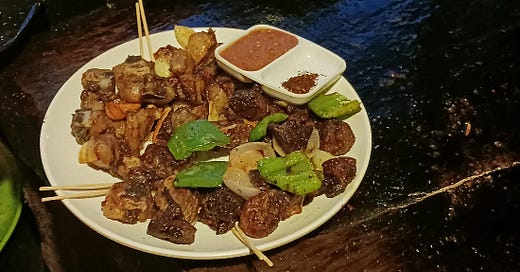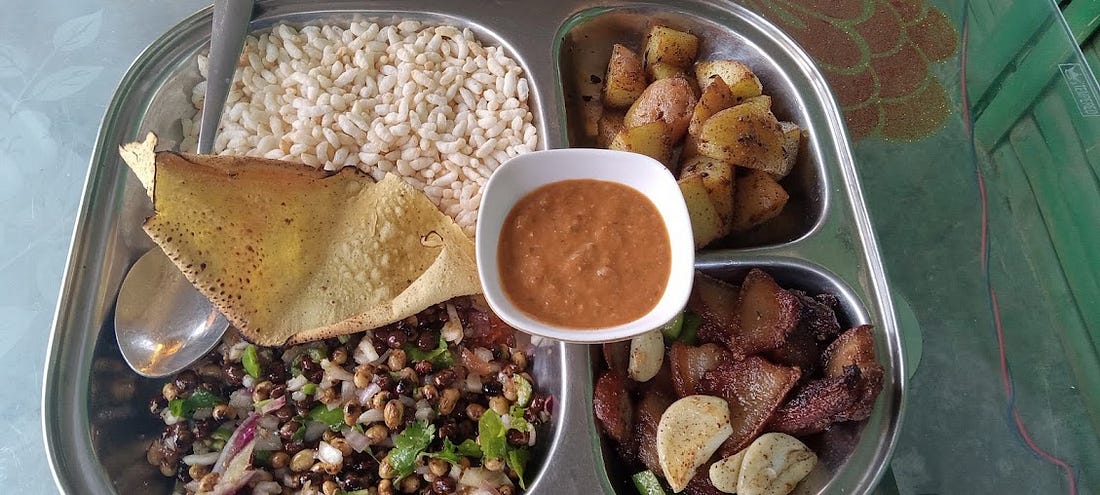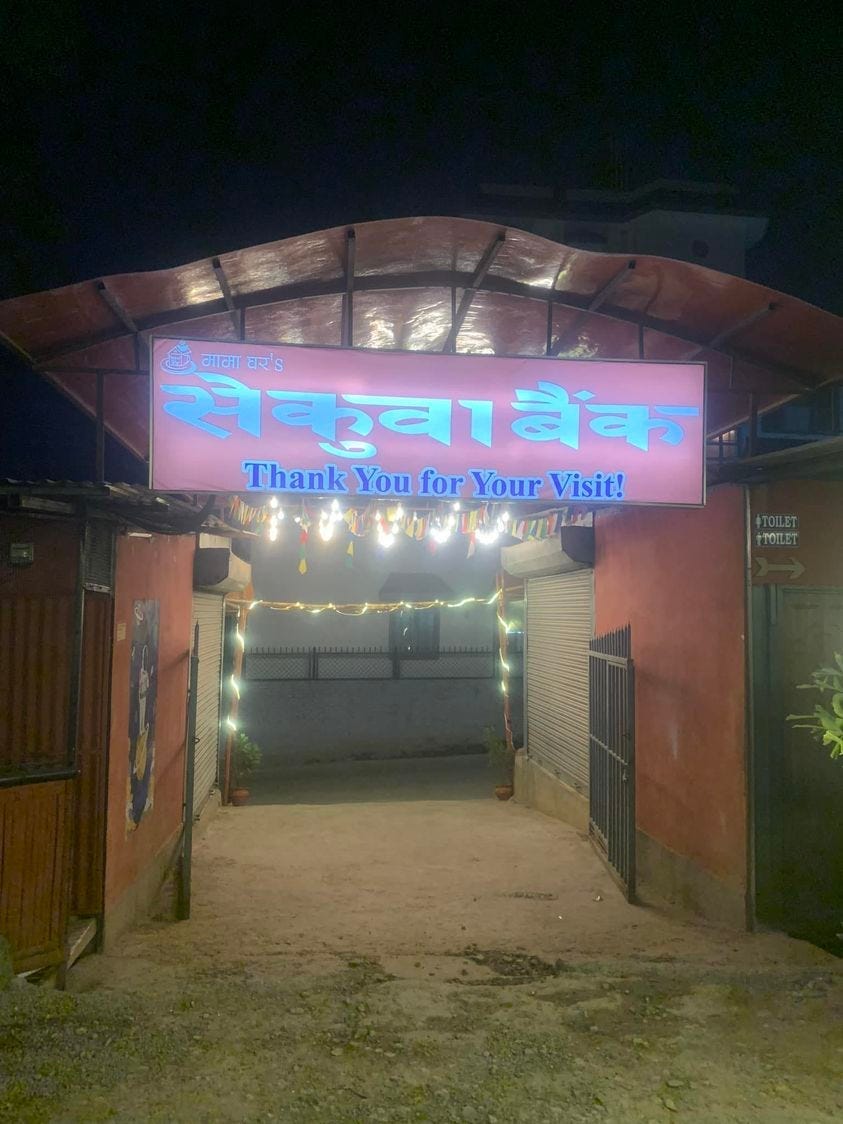How the Nepali Dish Sekuwa Became My Mental Gateway to the Country
A diversion from the usual to celebrate the holidays
Dear readers: This week is a busy one for me, owing to the holiday season. For this Christmas Day, I will retreat into a warm (and tasty) memory. May you all find happiness and peace.
Traditional style pork Sekuwa with roasted potatoes and vegetables. (photo by author)
During this Christmas season, with all the hams, cookies, and other holiday foods being served, I find myself missing one I came to love while living in Nepal: sekuwa. Although it is a cultural icon with a powerful pedigree there, I only became acquainted with it in recent times — a tardiness I regret.
In 2023 and 2024, I lived in an apartment in the outer reaches of Kathmandu, the capital city of Nepal. This neighborhood once consisted almost exclusively of cow pastures and farm fields dotted with scattered homesteads. In the last ten years, however, it has exploded into an eclectic sub-city, another tendril of the chaotic leviathan that Kathmandu has become.
Today, Mandikhatar — as the neighborhood is known — hosts a variety of metropolitan elements: chic coffee shops, futsal arenas, medical centers, franchise convenience stores, and family-owned shops offering every kind of ware imaginable. Perhaps its most diverse addition, however, is the wide variety of themed restaurants that have sprung up. At one of these, I became acquainted with a Nepali tradition and made some new friends.
Nepal’s ‘BBQ’ is so much more
Owner Santosh Lama Gurung opened the Sekuwa Bank restaurant back in April of 2023, his second restaurant in the Kathmandu area. Hailing from far eastern Nepal, Santosh grew up in a culture that has cultivated the sekuwa cooking style over generations.
For many of the first years I spent in the country, some decades ago, I always assumed sekuwa meant barbecue. After all, many Nepali vendors refer to it as such and, back in my early years, it was mostly featured at roadside stands that did not have descriptive menus and whose workers typically spoke dialects with which I was unfamiliar. Sekuwa actually derives from the word sekeko, which means something akin to ‘grilling.’
Although I like barbecue, I never felt compelled to try the dish there. I suppose I assumed that it was co-opted from the American south or Latin America where such flavors are second to none. My thought process was likely colored by the prevalence of ‘buffalo chicken wings’ in Kathmandu of which—as a native of Buffalo, New York — I can attest simply do not approach the standard. There seemed to be better choices for local delicacies, so Sekuwa simply never made the cut.
Too bad. For far too long, I was missing out.
Sekuwa is a meat dish. Depending upon the preference of the community making it, it might comprise buffalo, mutton, lamb, pork, chicken, or even wild meats. Some still adopt the long-used preservation technique of drying the meat before cooking it, either through sunning or smoking. We each have our own preferences, but I have found that pork and mutton tend to be the tenderest or most flavorful — even when pre-dried — and thus my favorites.
All prepare the dish through convective heating or smoking. At Sekuwa Bank, Santosh uses stones imported from the mountain areas that are heated by an open fire. The meat is cooked on these slabs, then transferred to a wood flattop stained and sealed with various flavored oils where it simmers for some time, absorbing the myriad aromas.
Simmering chicken at Sekuwa Bank. (photo by author)
The meat is dressed with any number of spices, again dependent on the tradition of origin. Like food from India, Nepali options tend to be ‘hot,’ though sekuwa is served at heats all across the spectrum. More poignant dishes include copious amounts of black pepper, chilies, and ginger, but turmeric, nutmeg, garlic, cumin, and cilantro are also common. One herb that gives Nepali dishes their unique flavor is Jimbu, which is native to the Himalayas.
In many restaurants in Nepal, one will find the ‘sekuwa set.’ It is a full meal that, in addition to the meat choice, includes sides such as beaten rice, roasted peanuts, sliced cucumber or carrots, and Nepalese pickles (which are fermented radishes). Santosh also offers chatpate, a tangy and spicy combination of peanuts, potatoes, vegetables, and spices. Wherever one goes, the sekuwa set’s rendition will likely vary somewhat. For first-timers to Nepal, you will never go wrong with ordering the set if your goal is to try localized traditional food.
A standard sekuwa set served, here, at Sekuwa Bank. (photo by author)
Sekuwa Bank was my personal refuge
Two key elements attracted me to Sekuwa Bank, leading to my introduction to this most wonderful meal. The first: convenient proximity. Like many suburban areas of Kathmandu, Mandikhatar is extremely hilly. A ‘short’ walk to a local establishment can still entail a vigorous hike.
Before Sekuwa Bank opened, the nearest sit-down restaurant required either fifteen minutes of walking almost entirely uphill, or twenty minutes heading downhill along a busy roadway. (And, of course, the latter meant returning up — so one did not escape a climb regardless). Sekuwa Bank, on the other hand, was just a hundred meters from the gate to my complex, along a relatively faint incline. By all accounts, an easy trip.
The second feature of the place that immediately caught my attention was its fabulous atmosphere. Even though it is set back from the road a little bit, the entrance way is readily apparent, especially at night.
The exit/entranceway to Sekuwa Bank. From this vantage point, you are looking out to the main road from inside the establishment. (photo by author)
Amidst the chaos of Mandikhatar’s urban environment, Sekuwa Bank was like a refuge. Its tables hover beneath aluminum sheeting, which protects patrons from the robust rains of the monsoon. Trees grace the entire compound, a blessed barrier from the intense sun of the spring and fall. At night, fires, torches, and electric lights give the feel of a countryside resort. For me, the place served as a wondrous retreat, a serene setting for getting work done on my laptop and socializing with newfound friends.
The atmosphere was made whole by its accommodating staff and cheery visitors. I met many fascinating people simply by virtue of being there, some of whom I maintain contact with to this day. Santosh himself played a profound role in this. His warm and talkative nature fostered connections that my tendency toward solitude and introverted aloofness would otherwise have precluded. I even befriended a local cat whose scars revealed the tough life he endured on the harsh streets of Kathmandu before Santosh gave him a home.
Sekuwa Bank at night. (photo by author)
Fond memories
One of the challenges with calling two places home is that you always miss one by virtue of staying at the other. At the time of this writing, I am back in the United States, preparing to enjoy Christmas and the New Year. Last year, I enjoyed these holidays in Nepal.
While I am delighted to spend the time this year with my American family, there remains a strong sense of absence. I write this article now, even though it has been some months since I last sat on one of the cushioned chairs of Sekuwa Bank, because telling this story reinvigorates the feelings of happiness and warmth that that place generated for me.
It gives me some faith that the global community can survive moments of darkness through connections just like these. If the ‘holiday spirit’ means anything at all, then this worldwide family I am part of, one that transcends culture and distance, must certainly be it. Happy Holidays!
Posing at the bar of Sekuwa Bank are: Ananda Tamang, Santosh Lama Gurung, Sandip Gurung, Rob Vanwey (your author), and Maniraj Rai. (photo by author)
* Articles post on Wednesdays and Saturdays - please consider sharing *
I am the executive director of the EALS Global Foundation. You can find me at the Evidence Files Medium page for essays on law, politics, and history; follow the Evidence Files Facebook for regular updates, or Buy me A Coffee if you wish to support my work.









I wish you could give the cooking recipe unless you know a place that makes it the way you liked it so I also can try it.